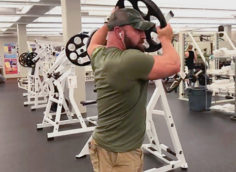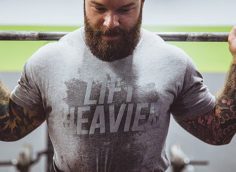Oftentimes, we hear more about the disadvantages of machines than we do the advantages. The popularity of multi-joint movements and free weights has increased exponentially over the last few years, much to the credit of CrossFit's ability to spark the interest of many when it comes to powerlifting and Olympic lifting.
But many people have totally written off the use of machines. In truth, there's value in both machines and free weights, no matter your goals. Yes, machines even have a place in CrossFit training.
In 2011, I opened a CrossFit affiliate. Although our facility had many pieces of equipment not standard to a typical CrossFit box, like a reverse hyper and a belt squat, things like a leg press, a lat pulldown, and a cable machine were not on hand. Having come into CrossFit with a strength and conditioning background, I was well aware of the value of using machines, but in reality it came down to one thing: their cost and the space these pieces take up.
But recently I started training in a commercial gym again for the first time in close to a decade. In just six weeks, machines like the leg press, leg extension, and hack squat have helped me put considerable size on my quads. And I recently hit my 1-rep max front squat for an easy double. The lesson? Machines, used appropriately, can improve your functional fitness training.
- Functional Resistance Machines. This is where resistance is offered in more natural movement patterns. Think of a cable machine where you can use pulleys in high or low positions for a variety of movements. Since the handles aren't fixed there's more leniency. Cable machines offer variability in terms of grips, handles, and heights.
- Non-Functional Resistance Machines. Still useful for isolating specific muscle groups for hypertrophy or rehabilitation.
- Machines can be used to target specific muscles, but offer little "real life" carryover like free weights do.
- Machines don't require much prerequisite skill level, making their risk low. But machines can force you to start in a compromising position where limbs and joints are in a biomechanically weak or vulnerable position.
- It's important to know that if a machine prevents any joint from moving, then there will usually by an increase in stress on an adjacent joint. On the other hand, it's more likely that there will be less compensation because we're able to isolate a particular muscle for hypertrophy or rehabilitation purposes.
- Machines neglect the explosive movements as well as the elastic qualities of the tendons and connective tissue, which are essential for sports and injury prevention.
- Machines allow for targeting a specific muscle at multiple angles, hence the reason why machines are a staple in any bodybuilder's routine. In addition, range of motion is instrumental in building muscle, but some athletes may not be able to use full ROM due to their own limiting factors. Machines offer a way to achieve full ROM without being limited by a lack of mobility or movement proficiency.
- Machines offer a safe way to implement mechanical drop sets, a time-tested method of building muscle. In this case, we can train to failure without the risk of a weaker muscle group compensating.
Your workouts should still consist of multi-joint movements, loaded carries, and unilateral work, but we can strategically use machines to help improve lagging muscle groups. We can also use machines as "activation" to warm-up for training session. Below are specific examples and a template of how your workout may look:
Lower-Body Warm-Up
3 Rounds of:
- 10 Seated Leg Curls
- 10 Walking Lunges with Overhead Reach
- 10 Cable Pallof Presses each side
Rest as needed between sets
Upper Body Warm-up
3 Rounds of:
- 10 Straight-Arm Lat Pulldowns (See video.)
- 10 Rope Tricep Extensions
- 10 Cable High to Low Woodchops
How to Set Up Your Workout
- Multi-Joint Movement
- Unilateral Movement
- Machine for Lagging Muscle
- Loaded Carry
- Abs/Band Work
In short, eliminating machines and only using barbells, dumbbells, and kettlebells may limit your progress. Of course, most functional fitness facilities don't have machines on hand, but the good news is that most commercial gyms offer low-rate memberships where you could supplement your current training regime.





